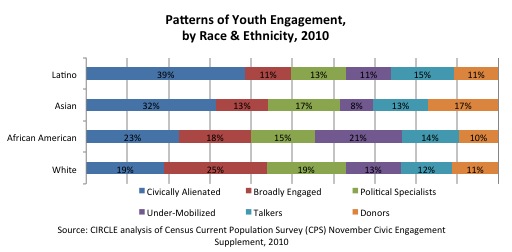Asian American Youth: Political Engagement Trends
The 2008 presidential election marked the highest reported voter turnout among Asian American youth[1] since 1992, with a rate of 43%.
This is one take-away from CIRCLE’s recently released fact sheet on the voting and political engagement trends of Asian American youth (ages 18-29), one of three facts sheets on electoral participation by youth of different racial and ethnic groups. The fact sheets include findings about patterns of engagement and recommendations for increased engagement.
Turnout among Asian American youth decreased to 36.2% in the 2012 election—the lowest rate among youth of different ethnic groups. The trend has been similar in midterm elections; in 2010, young Asian Americans turned out at a rate of just 17.6%, tied with the turnout rate of young Latinos for the lowest among all groups.
In 2012, young Asian American voters cast ballots for President Obama at a rate of 73% (CIRCLE analysis of National Asian American Survey data). At the same time, Asian American youth were the least likely to be registered to vote and had the lowest turnout in 2012 compared to their peers of other racial and ethnic backgrounds, and were generally less likely to engage in formal electoral politics. Of Asian American youth overall (i.e. voters and non-voters), 44% reported considering themselves independents in 2012 and 29.7% Democrats (CIRCLE analysis of Pew Asian American Survey data).
Asian American youth are significantly more likely than their peers of other ethnic groups to donate to charitable causes. However, as shown below, nearly one third of young Asian Americans are “civically alienated,” second only to Latino youth. Young Asian Americans are also among the least likely—again, second only to young Hispanics—to be “broadly engaged.” Still, Asian youth are the least likely group to be “under-mobilized” (defined as those who registered but did not vote).
Additional findings and recommendations include:
- In 2012, young Asian Americans were most likely (44%) to consider themselves independents. This suggests ample opportunities for candidates and parties from across the political spectrum to appeal to Asian youth.
- Research suggests that online efforts may prove promising. -ccording to research by Cohen & Kahne[2], Asian American youth were most likely to participate in interest-driven activities online. They also found that interest-driven activities were correlated to engaging in “online participatory politics.”
- In 2008, young Asian Americans without college experience showed the lowest turnout among all racial and ethnic groups, which points to a need for greater outreach to this subset of young people.
- Asian American youth have fallen behind their peers in voter registration. They must be targeted through personalized outreach that takes into account the ways they are already civically engaged, such as charitable donations and interest-driven activities.
Read the full fact sheet on Electoral Engagement among young Asian Americans, and see the related fact sheets for African American and Latino youth.
[1] We understand that the general label “Asian Americans” does not fully represent the linguistic, religious, cultural, and socioeconomic diversity within this group. Data with large enough sample sizes to do analysis by age and ethnic sub-group is scarce. However, there are also problems with not representing a group at all in research. Overall, readers should interpret statistics about Asian American youth with caution.
[2] Cohen, C., J. Kahne, B. Bowyer, E. Middaugh, and J. Rogowski. 2012. Participatory politics: new media and youth political action. (YPPSP Research Report). Retrieved from http://ypp.dmlcentral.net/sites/all/files/publications/YPP_Survey_Report_FULL.pdf






